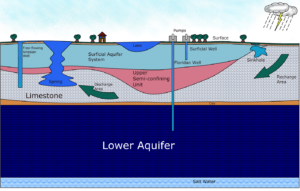What Should Your New Well Depth Be?
Do you intend to drill a well on your property? Do you need to know how to calculate the depth at which to drill a well? Find the answers by reading on.
Did you know that more than 23 million American households rely on private wells for their water supply?
In Florida, groundwater is the main source of water for many residents. As thousands of people pour into the state everyday, well drilling expertise has become more and more important.
However, how can you know how deep to drill a well? The final well depth varies depending on the local geology and the amount of subsurface water. To calculate how deep the finished well will be, drilling companies rely on their expertise, knowledge, and best guesses. 
How to Calculate the Depth of a Well
To what depth you should dig to create a new well, there is no single solution. It is comparable to asking, “How long is a piece of string? ” The typical depth of a water well is 300 feet, although they can go as deep as 800 feet.
This well depth solution is dependent upon a number of factors:
Local Building Regulations And Codes
When drilling wells, the local building laws and regulations are the most crucial factor to take into account.
There are a few things to consider in this situation. The well casing must first reach bedrock and be at least 25 feet long in order to comply with the fundamental requirement for water wells.
You should also consider the following:
- Well-cap reinforcement
- Well sealing
- Well grouting
State to state and even city to city variations exist for each of these. If you have any questions about these codes, you may always contact the municipal public offices in your area.
The specialists at a reputable well-drilling business, however, can typically steer you in the proper way.
Considerations For Water Quality
In general, the water quality improves as you go deeper. This is due to the fact that water nearer the surface might become contaminated by organisms from the soil. In addition, chemical pollutants can contaminate the water at the top by entering the system.
Because of this, the majority of local governments have regulations on the bare minimum depth of wells.
Generally speaking, it’s advised to keep a well’s depth several feet deeper than what the local authority specifies as the minimum depth.
Many states have laws requiring drilling to go a specific minimum depth in order to reduce dangers.
Rocky Structures
The amount of rocky terrain also has an impact on the water table below the surface. If the subsurface topography is made up of highly rocky layers, water can reach thousands of feet below the surface.
The depth should match the pipe’s wall thickness. This implies that a thicker pipe is required for more storage capacity.
These geological characteristics will determine the depth of your water well. Consequently, your contractor will be very familiar with them.
Alterations To The Water Table
The point at which the ground gets entirely wet is known as the “water table.” It is a variable that changes over the course of a year. This is due to a number of causes, the most important of which are variations in seasonal rainfall.
Most of the time, before they begin drilling, your contractors will take some time to determine how high the water table is. By examining data from the previous few years, they will attempt to determine the lowest water table threshold of the year. 
Well Longevity, Draw Rate, And Silting
Deeper wells often have longer lifespans. Why? In addition to having low draw rates, these wells also have low silt levels recorded at the bottoms of them.
Silting: Poorly installed wells can “silt up,” where grit or sand gets into the pump and mixes with the water being pumped. Of course, some wells are dug deep to prevent silting, allowing years to pass before issues arise.
Deep wells quickly silt up. Because removing silt is expensive, shallow well maintenance costs increase. It’s also challenging to locate silt-cleaning services.
Rate Of Well Draws: Your well drilling experts will think about draw rate in addition to depth issues. This is how quickly the pump draws water up from the well.
Naturally, you want the draw rate to be swift enough to deliver enough water, but not so quick that silt or other debris enters the system.
Keeping Water Surface Contamination To A Minimum: As was already said, bacterial and soil organism contamination of water is less likely the deeper the well.
Although the water must pass through dirt and rocks in order to reach the surface in the case of extremely deep wells, this increases the possibility that debris will enter the water stream.
Similar to this, when deep wells are involved, there is a greatly increased chance of minerals getting into the water supply.
Deep well maintenance is often more expensive due to the necessity to treat water with a high mineral content before it is fit for human consumption.
Wells should therefore not be excessively deep or too shallow. In order to avoid affecting the quality of the water, the depth should be sufficient.
How Deep Should A Water Well Be?
It is recommended for drinking water wells to be at least 100 feet deep so that contaminants from the surface cannot enter the well. Private homes typically have wells that are between 100 and 800 feet deep.
Since the actual answer is “it depends,” well drilling, in essence, calls for expert to handle the job. A knowledgeable contractor is capable of making choices based on experience and expertise.
Accuracy increases with increased knowledge.
With that in mind, there is one well-drilling company in Florida with tons of experience and thousands of happy customers.
Jon’s Well and Pump Services Inc is the answer to any well related issues!
Call us today at 386-801-5334 or visit our website.

